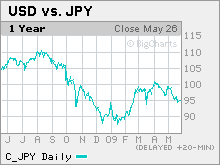Yen falls against the dollar
American durable goods orders and weekly jobless claims support risk appetite, attracting Japanese investors.
NEW YORK (Reuters) -- The yen fell broadly Thursday as a spike in U.S. bond yields and better-than-expected data in the United States attracted Japanese investors into overseas assets.
Investors sold the yen, while buying assets in higher-yielding currencies such as the euro, the U.S. and Australian dollars and in emerging markets, such as Brazil.
Reports in the United States showing better-than-expected readings on durable goods orders and weekly jobless claims also supported some risk appetite, hurting the dollar versus the euro while boosting it against the yen.
"There's a clear move out of the yen but the buying is not only concentrated in U.S. dollars," said Win Thin, a currency strategist at Brown Brothers Harriman in New York. "Other currencies such as the Australian dollar and some of the large emerging markets are being favored as well."
Yields on 10-year U.S. government bonds have jumped more than 50 basis points in the last two weeks, driven in part by worries about the ever-expanding amount of debt needed to fund a record $1.75 trillion U.S. budget deficit.
U.S. 10-year Treasurys now yield around 3.8% against 1.5% for the Japanese equivalent.
"The rise in long-term bond yields is attracting Japanese investors back into the U.S. Treasury markets," said Kathy Lien, director for currency research at GFT Forex in New York. "The biggest story in the currency market today is in dollar/yen. Its sharp rise has pushed all of the Japanese yen crosses higher."
In midday trading in New York, the dollar was up about 1.5% at ¥96.74, its highest in more than two weeks and pulling away from a two-month low of ¥93.85 hit last week. The euro was up 2.4% at ¥134.96, according to Reuters data.
The yen also shed more than 2% of its value against higher-yielding currencies such as the Australian and New Zealand dollars and fell versus the Brazilian real.
Dollar-euro: The dollar fell against the euro after government reports showed the number of U.S. workers filing new claims for jobless pay dropped last week, while new orders for long-lasting U.S. manufactured goods rose more than expected in April.
But the greenback briefly pared some of its losses after another report showed lackluster housing data.
"Data in the U.S. has stopped getting worse, which is supportive for the dollar against the yen, but it takes off its safe-haven bid versus the euro," said BBH's Thin.
The euro was last 0.8 % higher at $1.3949.
Data from the Ministry of Finance showed Japanese investors returned from the Golden Week holidays and bought foreign bonds last week. At the same time, retail investors poured $2.4 billion into mutual funds on Wednesday, in the biggest single-day of fund launches this year, industry sources told Reuters.
The big flow of Japanese investor money into funds investing in overseas shares and U.S. junk bonds may have added to selling pressure on the yen against the dollar, currency dealers said.
Todd Elmer, a currency analyst at Citigroup in New York said in a note that despite the recent outperformance of Japanese equities the difference between flows to Japan and other parts of Asia is "striking" and that buying other Asian currencies against the yen is a "good long term strategy."
The recent sharp rise in U.S. yields has come despite strong demand at the two Treasury auctions this week -- notably from foreign investors -- which has soothed some concern over the long-term U.S. sovereign credit ratings outlook and supported the dollar. ![]()



